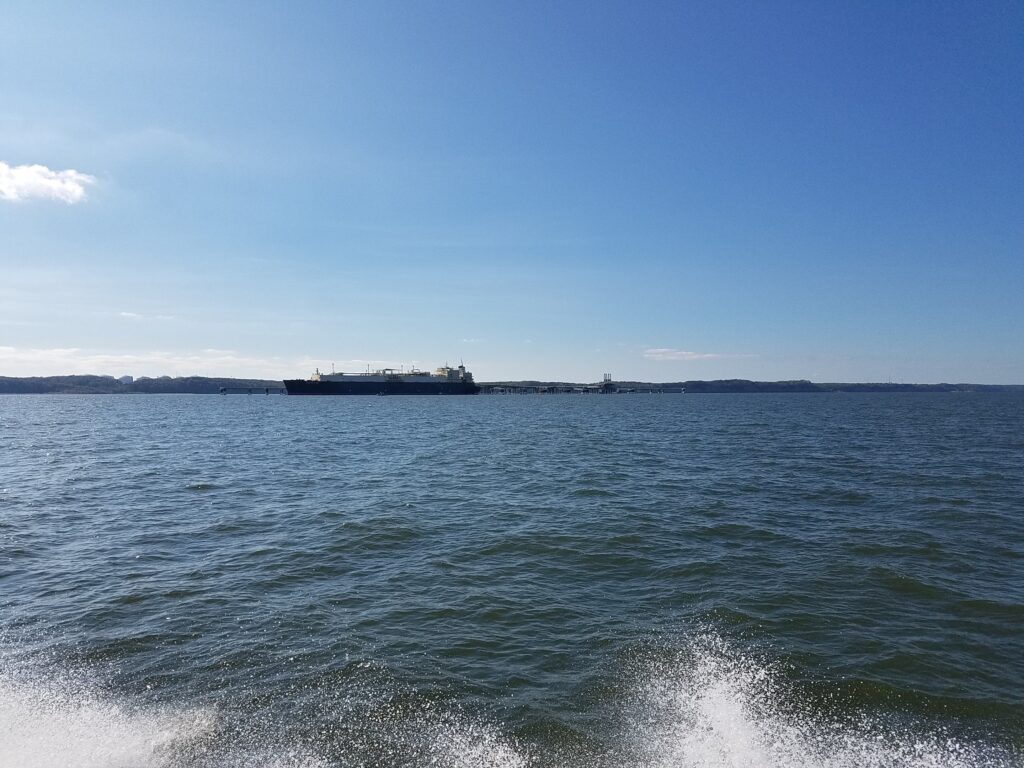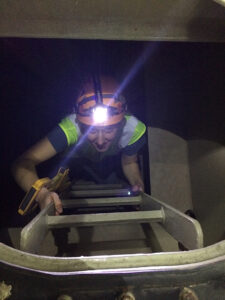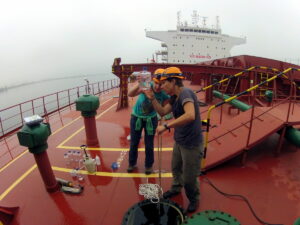by Dr. Jenny Carney
A few years ago, a massive tanker leaving lower Chesapeake Bay with a cargo of natural gas was a rare sight. Today—thanks to the booming liquefied natural gas (LNG) production on U.S. soil—they’ve become commonplace.

The U.S. is now the largest exporter of LNG globally. In July 2022, exports from all U.S. LNG facilities averaged 11.1 billion cubic feet per day. Further LNG export projects are underway in the U.S., which could expand combined daily export capacity by another 5.7 billion cubic feet daily.
At the Smithsonian Environmental Research Center (SERC), scientists in the Marine Invasions Laboratory study an underreported side effect of this trade: how shipping can transport invasive species around the globe, by picking up aquatic “hitchhikers.” In a new project, I and others in the lab are attempting to zero in on the trade’s impact in Chesapeake Bay.
Importing Hidden Invaders
Commercial shipping is a major vector for the movement of aquatic organisms, with ballast water thought to have been responsible for the successful introduction of hundreds of harmful species in the U.S. and worldwide. Commercial vessels, particularly tanker and bulk cargo vessels, need to periodically load and unload ballast water inside tanks in their hulls to ensure they maintain a safe height in the water during transit. When ballast water is pumped onboard, many organisms get pumped into the tanks as well, and consequently ships are transporting organisms around the world daily.
For the last six years, researchers like myself, Dr. Kim Holzer and Dr. Greg Ruiz have been watching this growth in LNG export from the U.S., with an interest in how this change in trade behaviour will affect shipping patterns both locally and nationally. In an earlier study published in 2017, scientists led by Holzer, a former SERC postdoc, predicted that annual U.S. LNG export would increase 90-fold by 2040. In addition, the study predicted U.S. ports would become more connected than ever, as new trade routes between LNG suppliers and LNG markets emerged. Some ports would see ships arriving from places they’d never previously encountered. That could pose a serious invasive species risk, as the organisms hitchhiking in their hulls would be new as well.
Our latest project, funded by the Mid-Atlantic Panel of Aquatic Invasive Species, launched in 2019. We’re focusing on one site in particular: an export facility that opened 2018 at Dominion Cove Point LNG terminal.
The terminal at Cove Point sits in the mid-Chesapeake Bay in Lusby, Maryland, far from the major ports of Baltimore and Virginia’s Hampton Roads. As such, this location had previously received negligible vessel traffic. But all that has changed in the last five years.
To gather info, we used vessel arrival and ballast water discharge data collected by the National Ballast Information Clearinghouse between 2005 and 2021, which allowed us to see how drastically shipping trade had changed at the site and how these changes impacted Chesapeake Bay shipping as a whole. We chose Cove Point as a case study, in order to understand the impact opening an LNG export terminal could have on local vessel traffic (like changes in vessel activity, volumes of ballast water discharged and the sources of this ballast water).
Before 2018, few commercial ships visited Cove Point. It received minimal amounts of ballast water from domestic ships, and had never received ballast water from overseas. That all changed with the opening of the LNG export terminal. In 2021, 3.3 million cubic meters of ballast water were discharged at the site, representing 14% of the total annual ballast water discharges to Chesapeake Bay.
Keeping Exports Up and Invaders Down
While this may sound bleak, the LNG tankers aren’t blind to the threat—and the study uncovered evidence that they’re taking action. The U.S. Coast Guard requires that all overseas ballast water discharges in U.S. ports (with a few minor exceptions) must be treated for potential invaders using onboard water treatment systems like UV irradiation, chlorination, microfiltration). As a result, high volumes of ballast water discharged at Cove Point are treated prior to discharge. In 2021, 83% of overseas ballast water discharge at the site had been treated, higher than the national average of 74%. With regards to environmental protection, this is very positive and highlights the compliance of the arriving LNG tankers with requirements to treat ballast water discharges.
As well as a rise in ballast water at Cove Point, we also saw the emergence of new port connections in Chesapeake Bay. In 2021, 40% of the ballast water discharged at Cove Point came from new source ports (ports that didn’t discharge water anywhere else in Chesapeake Bay). In total, 30 novel source port connections have been made so far. The new connections spanned across Asia, Europe and South America, but they clustered around Japan and Korea. While the new connections represent a boon for U.S. trade, it also poses higher risk of new invasive species introductions than if the ballast water increase came from established trading partners.
With current global events, the export of LNG from the U.S. is set to increase, and so trade at Cove Point is expected to remain high for the foreseeable future. The creation of this facility has resulted in a new hotspot for ballast water discharges in the Chesapeake Bay, and has linked Chesapeake Bay to many novel source ports. However, the prevalence of ballast water treatment reported on discharges at Cove Point is extremely positive and should provide protection against new potential invasions.
Go Deeper
Out of the Ballast Tank & Into the Waters, Part 1: Hidden Hitchhikers Take a Transoceanic Trip
Out of the Ballast Tank & Into the Waters, Part 2: How to Wrangle Invaders from Every Angle



